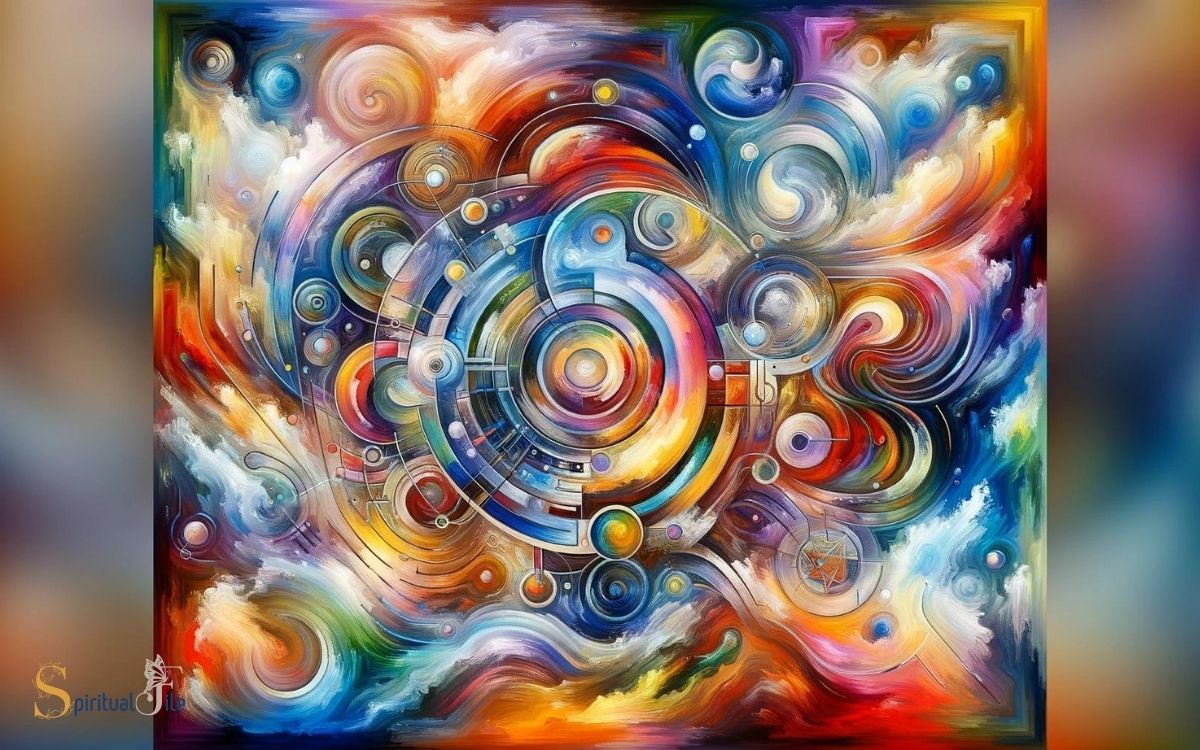Using Art in Spiritual Direction: Emotions!
Art in spiritual direction serves as a powerful medium to explore inner experiences, emotions, and beliefs.
Integrating creative processes like painting, drawing, or sculpting can help individuals express the inexpressible aspects of their spirituality, providing a tangible form to abstract spiritual concepts and facilitating a deeper understanding of one’s personal faith journey.
Spiritual direction often involves one-on-one sessions with a spiritual director who guides individuals to reflect on their relationship with the divine, the sacred, or their inner self.
Art complements this process by:
For example, a person might draw a path winding through various terrains to represent their spiritual journey, with different colors and images symbolizing various experiences and emotions along the way.
Embracing art within spiritual direction offers a unique pathway to accessing and understanding the deeper layers of one’s spiritual existence, transcending the limitations of verbal communication.

Key Takeaway
The Power of Artistic Expression
The power of artistic expression lies in its ability to convey deep emotions and spiritual insights through visual, tactile, and auditory means. As an artist, I have experienced firsthand the profound impact that art can have on individuals seeking spiritual understanding.
Through visual art, one can communicate the ineffable aspects of the human experience, transcending language and cultural barriers to touch the core of our shared humanity.
The tactile nature of creating art also allows for a deeply embodied experience, connecting the physical and spiritual realms in a way that words often cannot.
Additionally, the auditory elements of art, such as music or spoken word, provide yet another avenue for exploring and expressing spiritual truths.
Art has the power to evoke contemplation, introspection, and connection, making it a valuable tool in spiritual direction.
Understanding Symbolism and Imagery
An understanding of symbolism and imagery is essential in utilizing art for spiritual direction. When exploring art with individuals, I find it crucial to delve into the meanings behind the symbols and the emotions evoked by the imagery.
Sometimes, a simple color or object can hold deep significance for someone’s spiritual journey. Through discussing these elements, we can uncover profound insights and connections to their inner world and spiritual beliefs.
It’s important to approach symbolism and imagery with sensitivity and an open mind, allowing the individual’s interpretation to guide the dialogue.
As a spiritual director, I aim to create a safe space where these symbols and images can be explored without judgment, fostering a deeper understanding of the individual’s spiritual path.
Integrating Art Into Spiritual Practices
I’ve found that integrating art into spiritual practices can be a powerful way to connect with the sacred. Art serves as a sacred expression, allowing individuals to tap into their innermost thoughts and emotions.
Visual storytelling in spirituality and the use of symbols in spiritual art can deepen the understanding of one’s spiritual journey.
Art as Sacred Expression
As someone who has practiced spiritual direction, I’ve found that art serves as a powerful vehicle for sacred expression within spiritual practices.
Art provides a unique way to connect with the divine and express the ineffable aspects of spirituality. When integrated into spiritual practices, art can deepen one’s connection to the sacred by allowing for personal interpretation and exploration.
Through art, individuals can access deeper levels of introspection and contemplation, fostering a greater understanding of their spiritual journey.
Art also offers a tangible representation of spiritual experiences, serving as a visual reminder of the divine presence in everyday life.
- Art enables a non-verbal expression of spiritual experiences.
- It allows for a deeper exploration of personal spirituality.
- Art provides a tangible representation of the divine presence.
Visual Storytelling in Spirituality
In my experience of spiritual direction, integrating art into spiritual practices through visual storytelling has enriched the depth and meaning of spiritual experiences.
Art has the power to communicate and evoke emotions in ways that words alone cannot. Visual storytelling, through various art forms such as painting, sculpture, or even digital art, allows for a more profound exploration of spiritual themes and personal narratives.
Below is a table representing the emotional impact of visual storytelling in spirituality:
| Art Form | Emotion Evoked |
|---|---|
| Painting | Serenity |
| Sculpture | Reverence |
| Digital Art | Wonder |
| Mixed Media | Connection |
These emotional responses can facilitate a deeper connection to one’s spirituality and aid in the contemplation of spiritual truths.
Symbols in Spiritual Art
Continuing from my experience of integrating art into spiritual practices, symbols play a significant role in spiritual art, serving as powerful conduits for conveying deeper spiritual meanings and insights.
- Symbols in spiritual art often draw from cultural, religious, and mythological traditions, offering a rich tapestry of imagery that resonates with spiritual seekers.
- These symbols can evoke emotions, ignite contemplation, and facilitate connections to the divine or transcendent aspects of spirituality.
- When used in spiritual direction, symbols in art can spark meaningful conversations, aid in personal reflection, and deepen one’s understanding of spiritual truths.
Art-Based Reflection and Meditation
I love how art can serve as a powerful tool for introspection and reflection. It’s incredible how visual expression can provide a gateway to exploring our inner thoughts and emotions.
Additionally, using art as a form of prayer and recognizing the symbolism within spiritual art can deepen our meditation experiences.
Visual Expression for Introspection
One important aspect of using art in spiritual direction is the use of visual expression for introspection through art-based reflection and meditation.
When engaging in visual expression for introspection, individuals can benefit from:
- Exploring emotions and inner thoughts through creative mediums, fostering a deeper understanding of oneself.
- Using art as a tool for meditation, allowing for a peaceful and reflective space to contemplate spiritual insights.
- Creating visual representations of spiritual experiences, providing a tangible way to connect with and express one’s faith journey.
This approach encourages individuals to engage with their spirituality in a unique and personal way, utilizing art as a means of introspection and meditation to deepen their spiritual understanding.
Art as Prayer Tool
When engaging in spiritual direction, art serves as a powerful tool for prayer through art-based reflection and meditation. As I guide individuals in their spiritual journeys, I often encourage them to use art as a means of connecting with the divine.
Through art-based reflection, individuals can visually express their thoughts, emotions, and experiences, allowing for a deeper understanding of their spiritual path.
Art becomes a form of meditation, offering a space for quiet contemplation and a means to communicate with the divine in a non-verbal manner.
This practice enables individuals to enter into a state of prayerful awareness, fostering a deeper connection with their spirituality.
Art-based reflection and meditation provide a unique way to engage with the divine and explore one’s innermost thoughts and feelings. This approach can lead to profound spiritual insights and personal growth.
Symbolism in Spiritual Art
Art-based reflection and meditation continue to serve as a powerful means for individuals to visually express their thoughts, emotions, and experiences in their spiritual journey, fostering a deeper connection with their spirituality.
- Symbolism in art allows for personal interpretation and reflection.
- Art provides a tangible way to explore and express abstract spiritual concepts.
- Engaging with spiritual art can lead to deeper self-discovery and understanding of one’s faith journey.
Exploring Emotions Through Art
In exploring emotions through art, I find that creating visual representations can offer a powerful means of expression and reflection. Art provides a safe space to delve into complex emotions, allowing for a deeper understanding of the self.
Through the use of colors, shapes, and textures, I can visually articulate experiences that may be challenging to express verbally. Engaging in art-making processes not only helps to externalize feelings but also provides a tangible object to contemplate and explore.
Below is a table illustrating the emotions often explored through art:
| Emotion | Visual Representation |
|---|---|
| Joy | Bright colors and lively brushstrokes |
| Sadness | Dark hues and heavy, downward strokes |
| Fear | Sharp lines and chaotic compositions |
| Peace | Soft, flowing lines and calming colors |
| Anger | Bold, aggressive marks and intense colors |
Engaging with art in this way can be a transformative tool for self-discovery and emotional processing, leading to deeper spiritual insight.
Facilitating Spiritual Insight Through Creativity
As the process of exploring emotions through art unfolds, facilitating spiritual insight through creativity becomes a natural extension of this deeply personal and introspective journey.
Through the use of various artistic mediums, individuals can delve into their innermost thoughts and feelings, leading to profound spiritual insights.
This process can help individuals:
- Gain a deeper understanding of their spiritual beliefs and experiences
- Uncover hidden emotions and challenges that may be hindering spiritual growth
- Foster a greater sense of connection with the divine and the world around them
Nurturing Spiritual Growth With Art
Engaging in creative activities allows me to nurture spiritual growth through the exploration of my innermost thoughts and feelings, fostering a deeper connection with my spiritual beliefs and experiences.
Art provides a space for me to reflect on my spiritual journey, express gratitude, seek solace, and find meaning in life’s challenges.
Here’s an example of how art nurtures my spiritual growth:
| Artistic Practice | Spiritual Nurturing |
|---|---|
| Painting | Reflecting on my spiritual insights and experiences. |
| Journaling | Expressing gratitude and processing emotions. |
| Meditation | Seeking solace and finding inner peace. |
| Collage Making | Finding meaning in life’s challenges. |
| Sculpting | Connecting with the divine through creativity. |
Through these artistic practices, I deepen my spiritual awareness and nurture personal growth, creating a more profound connection with my spirituality.
Art as a Path to Transcendence
Exploring art as a path to transcendence deepens my spiritual connection and fosters a profound sense of inner peace and serenity. Engaging with art allows me to transcend the limitations of my physical existence and connect with something greater than myself.
Through the creative process and the interpretation of art, I embark on a journey of spiritual elevation, experiencing moments of transcendence that uplift my soul.
Art serves as a conduit for transcendence, enabling me to tap into the depths of my being and connect with the divine in a tangible and meaningful way.
- Art as a doorway to the ineffable
- Encountering the sacred through artistic expression
- The transformative power of engaging with art
Conclusion
As I continue to journey through the intersection of art and spirituality, I am constantly amazed by the transformative power of creative expression.
The ways in which art can open up new pathways for spiritual growth and insight are truly remarkable.
Through art, we can tap into deeper layers of our being and connect with something greater than ourselves. The possibilities are endless, and the potential for transcendence through art is truly awe-inspiring.






